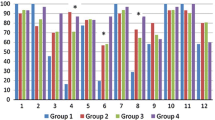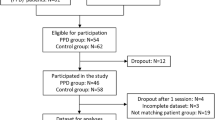Abstract
Introduction
Studies of the effect of pregnancy on olfactory function are contradictory—some report reduced function, others hypersensitivity, and still others no change at all. Our objectives were to quantify olfactory function in women during gestational and puerperal periods, to compare the olfactory test scores to those of non-pregnant women, and to explore the potential influence of rhinitis on olfactory function during these periods.
Methods
We evaluated olfactory function in 206 women with and without rhinitis—47 in the first trimester of pregnancy, 33 in the second, 44 in the third, 32 in the postpartum period, and 50 who were non-pregnant. Olfactory assessment was performed using the University of Pennsylvania Smell Identification Test (UPSIT) and ratings of the pleasantness and intensity of four common odors.
Results
Although total UPSIT scores did not differ among the study groups, pregnant and postpartum women identified some odors less well than did the controls. Pregnant women, especially in the first trimester, tended to consider some smells less pleasant. Rhinitis was adversely associated with the olfactory test scores of the pregnant and postpartum women.
Conclusions
The overall olfactory function of postpartum and pregnant women did not differ compared to controls; however, detection of some individual UPSIT items was adversely impacted (e.g., menthol, gingerbread, gasoline). Rhinitis was associated with reduced olfaction during pregnancy and puerperium.
Implications
These findings support the view that pregnancy-related alterations in smell are idiosyncratic, present only for some odorants, and may be impacted by the presence of rhinitis that commonly occurs during pregnancy.


Similar content being viewed by others
References
Cain WS (1982) Odor identification by males and females: predictions vs. performance. Chem Senses 7:129–142
Cameron EL (2007) Measures of human olfactory perception during pregnancy. Chem Senses 32:775–782
Cameron EL (2014a) Pregnancy and olfaction: a review. Front Psychol 5:1–11
Cameron EL (2014b) Pregnancy does not affect human olfactory detection thresholds. Chem Senses 39:143–150
Cantoni P, Hudson R, Distel H, Laska M (1999) Changes in olfactory perception and dietary habits in the course of pregnancy: a questionnaire study. Chem Senses 24:58
Caparroz FA, Gregorio LL, Bongiovanni G, Izu SC, Kosugi EM (2016) Rhinitis and pregnancy: literature review. Braz J Otorhinolaryngol 82(1):105–111
Dalton P (1996) Odor perception and beliefs about risk. Chem Senses 21:447–458
Doty RL (1976) Reproductive endocrine influences upon human nasal chemoreception: a review. In: Doty RL (ed) Mammalian olfaction, reproductive processes and behavior. Academic Press, New York, pp 295–321
Doty RL, Mishra A (2001) Olfaction and its alteration by nasal obstruction, rhinitis , and rhinosinusitis. Laryngoscope 111:409–423
Doty RL, Snyder P, Huggins G, Lowry LD (1981) Endocrine, cardiovascular, and psychological correlates of olfactory sensitivity changes during the human menstrual cycle. J Comp Physiol Psychol 95:45–60
Doty RL, Shama P, Dann M (1984) Development of the University of Pennsylvania Smell Identification Test: a standardized microencapsulated test of olfactory function. Physiol Behav (Monograph) 32:619–623
Ellegård EK (2006) Pregnancy rhinitis. Immunol Allergy Clin N Am 26:119–135
Ellegård E, Karlsson G (1999) Nasal congestion during pregnancy. Clin Otolaryngol Allied Sci 24:307–311
Fessler DMT, Eng SJ, Navarrete CD (2005) Elevated disgust sensitivity in the first trimester of pregnancy. Evol Hum Behav 26:344–351
Flaxman SM, Sherman PW (2000) Morning sickness a mechanism for protecting mother and embryo. Q Rev Biol 75:113–148
Fornazieri MA, dos Santos CA, Bezerra TFP, Pinna F de R, Voegels RL, Doty RL (2015) Development of normative data for the Brazilian adaptation of the University of Pennsylvania Smell Identification Test. Chem Senses 40:141–149
Fornazieri MA, Doty RL, Bezerra TFP, de Rezende Pinna F, Costa FO, Voegels RL, Silveira-Moriyama L (2018) Relationship of socioeconomic status to olfactory function. Physiol Behav 198:84–89
Gilbert AN, Wysocki CJ (1991) Quantitative assessment of olfactory experience during pregnancy. Psychosom Med 53:693–700
Hansen R, Glass L (1936) Über den geruchssinn in der schwangerschaft. Klin Wochenschr 15:891–894
Hawkes CH, Doty RL (2018) Smell and taste disorders. Cambridge University Press, Cambridge
Henning H (1916) Der Geruch. Johann Ambrosius Barth, Leipzig
Henssge E (1930) Steigerung der Geruchsempfindlichkeit in der Schwangerschaft. Psychol Med 4:206–207
Hook EB (1978) Dietary cravings aversions during pregnancy. Am J Clin Nutr 31:1355–1362
Hummel T, Nordin S (2005) Olfactory disorders and their consequences for quality of life. Acta Otolaryngol 125:116–121
Hummel T, Rissom K, Reden J, Hähner A, Weidenbecher M, Hüttenbrink K (2009) Effects of olfactory training in patients with olfactory loss. Laryngoscope 119:496–499
Kim HJ, Park HJ, Park JY, Park HE, Lee SS, Bae JH (2011) The possibility of morning sickness from olfactory hypersensitivity during pregnancy. Korean J Otorhinolaryngol Neck Surg 54(7):473
Kölble N, Hummel T, von Mering R, Huch A, Huch R (2001) Gustatory and olfactory function in the first trimester of pregnancy. Eur J Obstet Gynecol Reprod Biol 99:179–183
Laska M, Koch B, Heid B, Hudson R (1996) Failure to demonstrate systematic changes in olfactory perception in the course of pregnancy : a longitudinal study. Chem Senses 21:567–571
Lee WH, Wee JH, Kim D-K, Rhee C-S, Lee CH, Ahn S, Lee JH, Cho YS, Lee KH, Kim KS, Kim SW, Lee A, Kim JW (2013) Prevalence of subjective olfactory dysfunction and its risk factors: Korean national health and nutrition examination survey. PLoS One 8:e62725
Loock J (2009) Allergic rhinitis and pregnancy – a review of the literature , with recommendations for management. Curr Allergy Clin Immunol 22:11–16
Lundström JN, McClintock MK, Olsson MJ (2006) Effects of reproductive state on olfactory sensitivity suggests odor specificity. Biol Psychol 71:244–247
Luvara A, Murizi M (1961) Ricerche di olfattometria in gravidanze. Boll Mal Orecch Gola Naso 79:367–375
Namazy JA, Schatz M (2014) Diagnosing rhinitis during pregnancy. Curr Allergy Asthma Rep 14:1–4
Navarrete-Palacios E, Hudson R, Reyes-Guerrero G, Guevara-Guzmán R (2003) Lower olfactory threshold during the ovulatory phase of the menstrual cycle. Biol Psychol 63:269–279
Noferi G, Giudizi S (1946) Le variazioni della sensibilita gustative in par- ticolari situazioni fisiologiche ed in alcuni stati morbois. Nota IV. Le variazioni dellasoglia gustative per l’acido e della soglia olfattiva per l’odre limone durante la gravidanza. Rev Crit Clin Med 5:89–100
Nordin S, Broman DA, Olofsson JK, Wulff M (2004) A longitudinal descriptive study of self-reported abnormal smell and taste perception in pregnant women. Chem Senses 29:391–402
Nordin S, Broman DA, Wulff M (2005) Environmental odor intolerance in pregnant women. Physiol Behav 84:175–179
Nordin S, Broman DA, Bringlöv E, Wulff M (2007) Intolerance to ambient odors at an early stage of pregnancy. Scand J Psychol 48:339–343
Nwankwo U, Fasunla AJ, Oladokun A, Nwaorgu OG (2017) Comparison between olfactory function of pregnant women and non-pregnant women in reproductive age group in Ibadan, Nigeria. Niger J Clin Pract 20:610–615
Ochsenbein-Kölble N, von Mering R, Zimmermann R, Hummel T (2007) Changes in olfactory function in pregnancy and postpartum. Int J Gynecol Obstet 97:10–14
Pence TS, Reiter ER, DiNardo LJ, Costanzo RM (2014) Risk factors for hazardous events in olfactory-impaired patients. JAMA Otolaryngol Head Neck Surg 140:951–955
Philpott CM, Conboy P, Al-Azzawi F, Murty G (2004) Nasal physiological changes during pregnancy. Clin Otolaryngol Allied Sci 29:343–351
Profet M (1992) Pregnancy sickness as adaptation: a deterrent to maternal ingestion of teratogens. In: Barkow JH, Cosmides L, Tooby J (eds) The adapted mind: evolutionary psycology and the generation of culture. Oxford University Press, New York, pp 327–366
Savovic S, Nincic D, Lemajic S, Pilija V, Mandic A, Rajovic J, Ivetic V (2002) Olfactory perception in women with physiologically altered hormonal status (during pregnancy and menopause). Med Pregl 55:380–383
Simola M, Malmberg H (1998) Sense of smell in allergic and nonallergic rhinitis. Allergy 53:190–194
Steiner G (1922) Psychische untersuchungen an schwangeren. Arch Psychiatr Nervenkr 65:171–190
Stuck BA, Hummel T (2015) Olfaction in allergic rhinitis: a systematic review. J Allergy Clin Immunol 136:1460–1470
Swallow BL, Lindow SW, Aye M, Masson EA, Alasalvar C, Quantick P, Hanna J (2005) Smell perception during early pregnancy: no evidence of an adaptive mechanism. BJOG 112:57–62
Weenen H, Olsen A, Nanou E, Moreau E, Nambiar S, Vereijken C, Muhardi L (2018) Changes in taste threshold, perceived intensity, liking, and preference in pregnant women: a literature review. Chemosens Percept. https://doi.org/10.1007/s12078-018-9246-x
Yasar M, Sagit M, Uludag SZ, Ozcan I (2016) Does odor and taste identification change during hyperemesis gravidarum? Medicinski Glasnik 13:50–55
Zacharisen MC (2000) Rhinitis in children, adolescents, the elderly, and pregnant women. Immunol Allergy Clin N Am 20:425–444
Zwaardemaker H (1895) Die Physiologie des Geruchs. W. Engelmann, Leipzig
Acknowledgements
We thank the Nurse Daiane Silva for her help in the collection of data and Fundação de Amparo à Pesquisa do Estado de São Paulo (FAPESP) for the financial support.
Statement of Authorship
Prof Fornazieri, Drs Prina, Silva, Ueda, and Favoreto conducted the data collection, conducted the analyses, drafted the initial manuscript, and revised the manuscript. Prof Fornazieri, Drs Prina, Pinna, Silva, and Favoreto conceptualized and designed the study and critically reviewed the manuscript; Profs Doty, Cameron, and Fornazieri provided statistical guidance and critically reviewed the manuscript; Profs Voegels and Doty coordinated the study and all authors approved the final manuscript as submitted.
Author information
Authors and Affiliations
Corresponding author
Ethics declarations
Funding
This work was supported by Fundação de Amparo à Pesquisa do Estado de São Paulo (2015/10195-9).
Conflict of Interest
RLD receives funding from the Michael J. Fox Foundation for Parkinson’s Research. He is a consultant to Acorda Therapeutics, Eisai Co., Ltd., Merck, and Johnson & Johnson. He receives royalties from Cambridge University Press, Johns Hopkins University Press, and John Wiley & Sons, Inc. He is President of, and major shareholder in, Sensonics International, the manufacturer and distributor of smell and taste tests, including the UPSIT.
Ethical Approval
The protocol was approved by the Institutional Research Board at Londrina State University.
Informed Consent
Volunteers signed a written informed consent prior to participation.
Additional information
Publisher’s Note
Springer Nature remains neutral with regard to jurisdictional claims in published maps and institutional affiliations.
Rights and permissions
About this article
Cite this article
Fornazieri, M.A., Prina, D.M.C., Favoreto, J.P.M. et al. Olfaction During Pregnancy and Postpartum Period. Chem. Percept. 12, 125–134 (2019). https://doi.org/10.1007/s12078-019-09259-7
Received:
Accepted:
Published:
Issue Date:
DOI: https://doi.org/10.1007/s12078-019-09259-7




